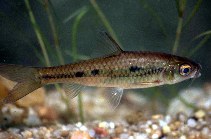| Family: |
Cyprinidae (Minnows or carps), subfamily: Smiliogastrinae |
| Max. size: |
15 cm SL (male/unsexed) |
| Environment: |
benthopelagic; freshwater, potamodromous |
| Distribution: |
Africa: Zambezi River system, Lake Ngami and Cubango rivers; Lake Malawi and the Ruo River; Lake Bangweulu and associated rivers; Luapula and upper Lualaba rivers; Orange, Limpopo, Comati and Vaal Rivers systems; Kunene and Cubango Rivers (Ref. 2801). East coast from Ruvuma, Tanzania to Umvoti, KwaZulu-Natal, also Orange, Cunene and Zambian Congo systems (Ref. 7248, 52193). Replaced in Okavango, upper Zambezi and Kafue by Enteromius poechii (Ref. 52193). |
| Diagnosis: |
Dorsal spines (total): 3-3; Dorsal soft rays (total): 8-8; Anal spines: 0-0; Anal soft rays: 8-8. Description: Body robust; 2 long barbels present (Ref. 52193). Dorsal fin with 3 spines and 8 soft rays; anal fin with 3 unbranched and 5 branched rays (Ref. 52193). Lateral line scales 31-35, 13-16 around caudal peduncle (Ref. 52193). Colouration: Silvery, tinged with gold when in breeding condition; usually 3 clear black spots on body and base of caudal peduncle (Ref. 52193). |
| Biology: |
Found in a wide variety of habitats, especially where there is vegetation (Ref. 52193), in shallow water near river outlets or close to swampy areas (Ref. 5595). It feeds on insects and other small organisms (Ref. 52193). Used as bait for the tigerfish (Ref. 7248). Breeds in summer, shoals of ripe adults moving upstream in spate after rain; females produce as many as 8,000 eggs (Ref. 7248, 52193). |
| IUCN Red List Status: |
Least Concern (LC); Date assessed: 19 June 2018 Ref. (130435)
|
| Threat to humans: |
harmless |
Source and more info: www.fishbase.org. For personal, classroom, and other internal use only. Not for publication.
